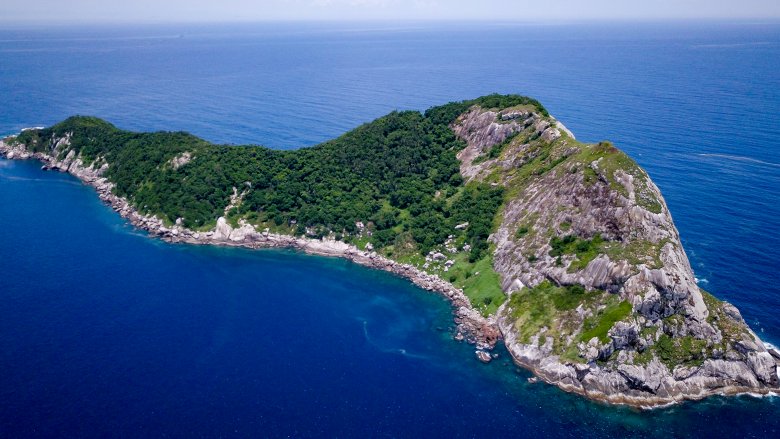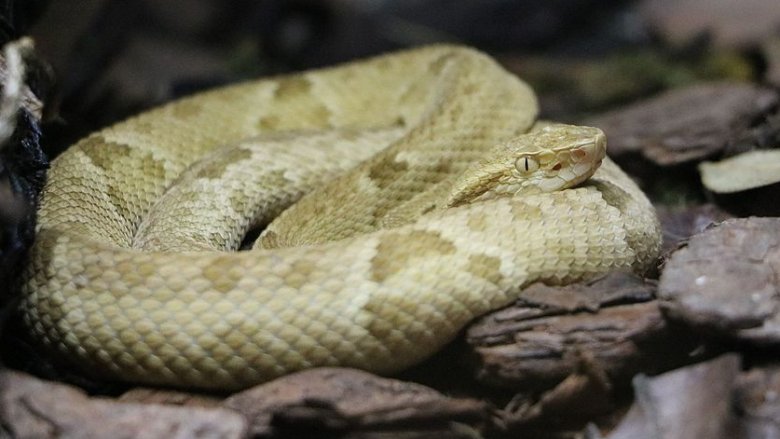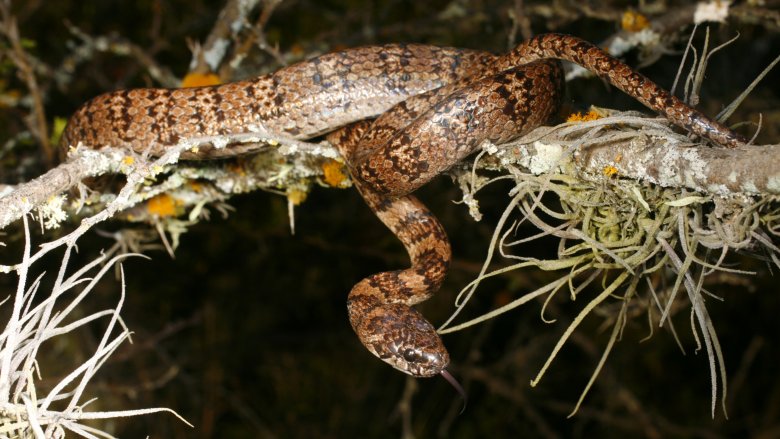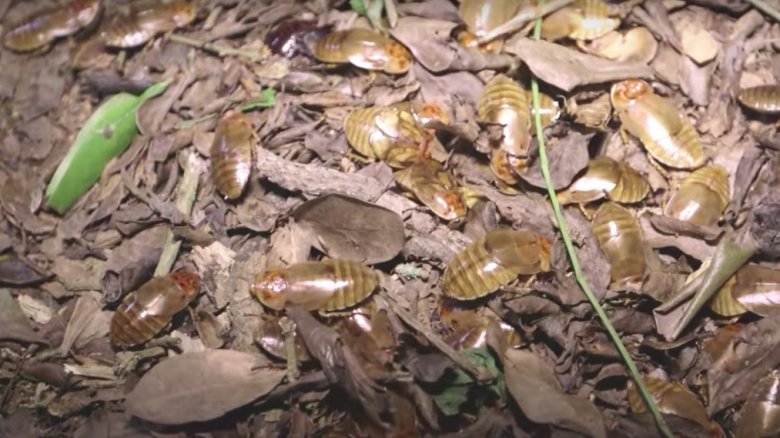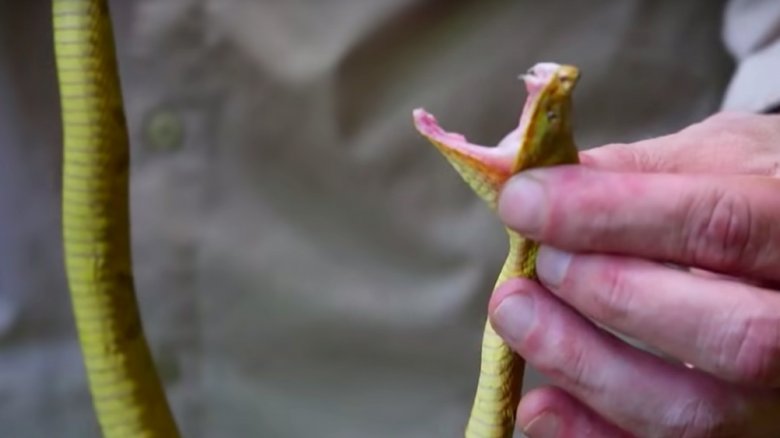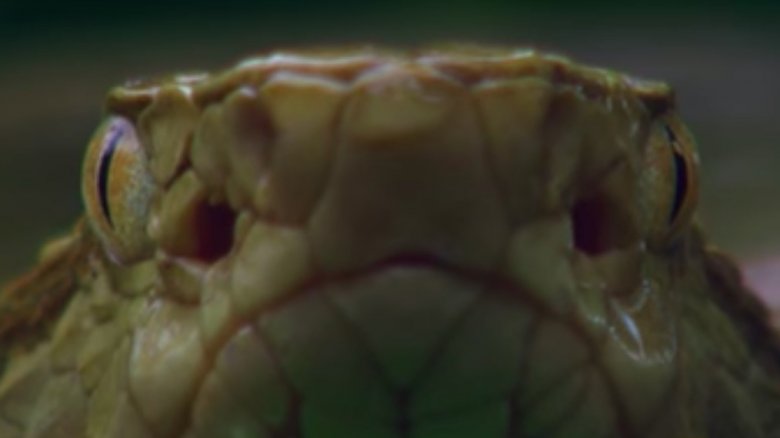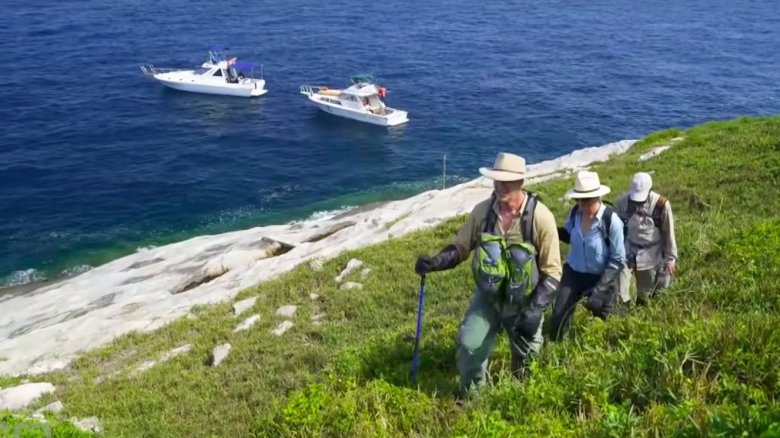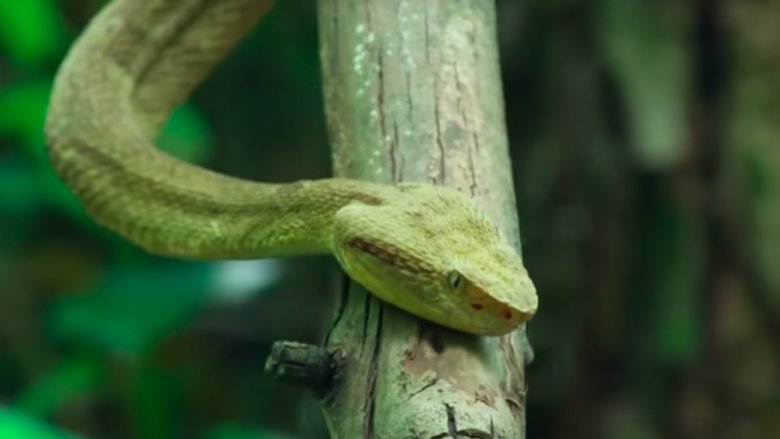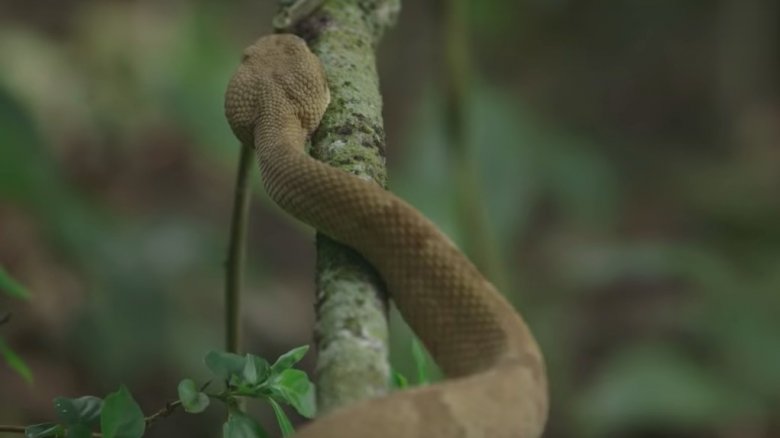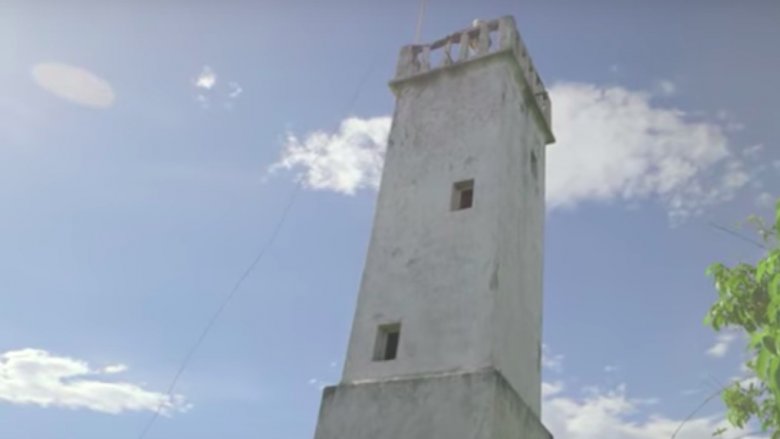The Untold Truth Of Snake Island
It sounds kind of like the name of some dumb reality TV show (actually it sort of is; thanks, Discovery Channel), but Snake Island is a real place, and that's what people actually call it, although locally it's known as Ilha de Queimada Grande. It's located about 90 miles off the coast of Sao Paulo, and from above it looks stunningly beautiful — it's got lush green forests, a beautiful rocky shoreline, sun, and surf — what more could an intrepid traveler want in an exotic destination? Besides, you know, the absence of actual mortal peril. Because Snake Island isn't called "Snake Island" because of the way it's shaped or because someone once saw a rainbow boa hanging from a tree or something. It's called that because it's home to one of the deadliest snakes in the world and oh yeah, there are literally thousands of them. Also the island is a mere 110 acres, which by the way is less than one-fourth of a square mile. So do the horrible math, and then check out this list of all the other horrible things you probably really didn't want to know about Snake Island.
Snake Island's golden lancehead is one of the world's deadliest serpents
The deadly snake that calls Ilha de Queimada Grande its home is probably not something you've ever heard of, and that's because Ilha de Queimada Grande is the only place you can actually find it. It's called the golden lancehead, and the name is quite descriptive — the snake is a lovely golden color and its head is shaped like a weapon of war, except if you get stuck by a regular lance you actually have a chance of survival.
Now, the golden lancehead is not the only member of the lancehead genus. According to Atlas Obscura, lanceheads are common in Brazil and are responsible for around 90% of all snakebite fatalities in that country. If you're bitten by a lancehead in mainland Brazil and you don't receive medical treatment you've got about a 7% chance of dying. If you do receive medical treatment, you still have a 3% chance of dying and your symptoms might include kidney failure, brain hemorrhage, intestinal bleeding, necrosis of muscular tissue — you know, standard stuff.
That's mainland lanceheads, though. The venom of the golden lancehead is thought to be as much as five times more potent than its wimpy mainland cousins, so yeah. There's a great reason why Snake Island is off limits to the average tourist.
Golden lanceheads aren't the only snakes on Snake Island
But golden lanceheads are not the sole slithery occupant of Snake Island. Of course they aren't. Snake Island is home to another snake species, called Dipsas albifrons, or Sauvage's snail-eater. Luckily for Snake Island's snail population, a 2005 study concluded that the island's population of Sauvage's snail-eaters were basically the same species as those found on the mainland, so unlike the golden lanceheads, there was no freakishly terrifying evolutionary trajectory blessing them with snail-killing laser beams coming out of their eyes or anything. And Sauvage's snail-eaters are non-venomous and therefore mostly harmless to anything that does not have a shell and a disgusting habit of leaving a silvery slime trail everywhere it goes, so we're all super excited about that. Still, Sauvage's snail eaters and golden lanceheads are kind similarly golden-colored, which means that the Sauvage's snail-eater could still make you behave irrationally and back up into a golden lancehead and get bitten anyway.
Also, Snake Island has terrifying bugs
Okay so Snake Island has deadly snakes and that's horrifying, and it has non-deadly snakes that are still sort of horrifying, but at least it doesn't also have giant cockroaches and terrifying locusts or anything.
Hey guess what, Snake Island also has giant cockroaches and terrifying locusts. Yes, that's right, according to Business Insider, anyone who dares to camp on the island better make sure to clean up after themselves or else they will be "knee-deep in cockroaches by morning." And once you've got that tent up you'd should probably plan to sleep on a cot because if you make your bed on the ground you'll be able to feel the roaches swarming around under you when you lie down.
"There are blue locusts and so many of these weird, prehistoric-looking cockroaches on the ground at night that it crunches when you walk," the Vice team who visited the island reported in their Snake Island documentary. "Place is f*cked. No one is allowed there for a reason. Don't ever go." Sage advice, team.
What happens to you if you get bitten by a golden lancehead on Snake Island?
You're probably wondering, "How bad can it be?" Because the bite from, say, a black mamba shuts down the nervous system and paralyzes its victims eventually leading to death in 100% of cases (unless the victim is really darn close to a vial of antivenom). So really, it couldn't possibly get any worse than that. Except that black mamba venom does not liquify your insides, so there's that.
According to Vice, "liquifying your insides" may be an exaggeration but it's likely that no one will ever really know for sure because no one has actually ever lived long enough to make it to a hospital, so it's not like doctors can put patient notes into a database or anything. The Brazilian mainland is about eight hours away by sea, so you'd probably have time to die a couple times before you could get anywhere near civilization.
"With these snakes it will be a particularly painful death," molecular biologist Bryan Fry (one of a handful of researchers insane enough to actually visit Snake Island) said on an episode of 60 Minutes. "You're going to die screaming." Hey Dr. Fry, do you think you could say that again but with less glee? Thanks.
There are thousands of snakes on Snake Island
We don't really know the exact number of snakes on Snake Island. Smithsonian says it's somewhere in the neighborhood of 2,000 to 4,000 (and that's just the golden lanceheads). From there, the media loves to extrapolate on just what that means from a snakes-per-square foot perspective, and that's kind of a harder number to pin down. Some researchers have guessed that the island has a snake density of one to five snakes for every 3 square feet of surface area, which is plenty. They also chill in the trees, so you might not see them on the ground necessarily.
On the other hand, Business Insider says visitors to Snake Island (because for some reason people actually go there sometimes) can expect to see one snake every 10 or 15 minutes, at least until they actually travel inland. Closer to the center of the island, the snake density is more like one snake every 54 square feet, which is kind of a long way from those other scary estimates. Still, why are we even talking about this? One deadly snake every 100 feet or every 1,000 feet is already way too many danged deadly snakes so really, Snake Island is terrifying and you should never go there and who cares what the actual snakes-per-square-feet statistics are.
There are no doctors on Snake Island but who cares, you're going to die anyway
People are mostly not allowed to go to Snake Island, but the Brazilian government does make a few exceptions. Researchers can sometimes go, for example, because researchers seem to think being insane is totally compatible with doing good science (sounds kind of like "mad science," but whatever). Anyway the Brazilian government has to grant researchers special permission if they want to come to the island and do whatever crazy research it is they want to do, so it's not like you can just pack up your test tubes and snakebite kit and just saunter on over there whenever you feel the need to do some mad science.
Smithsonian also says that no one is allowed to visit the island unless there's a doctor with them, which makes you wonder what doctor would be insane enough to accompany a bunch of insane researchers to such a totally insane place? And anyway the whole "must bring a doctor" rule does seem a little bit like an exercise in pointlessness since most people seem to think a bite from a golden lancehead is pretty much a death sentence regardless of how much medical attention you get. In fact Business Insider claims that a person who receives anti-venom immediately after a bite is likely to die anyway, so we'll say it again, just don't go to Snake Island because going to Snake Island is INSANE.
There probably isn't treasure on Snake Island, but that's never stopped the Discovery Channel before
According to local legend, the golden lancehead was first introduced to Snake Island by pirates, who put them there to act as a sort of legless, venomous watchdogs. Well, it's not true. There's no actual evidence for Snake Island's pirate/snake link, but a tenuous relationship with the facts has never really bothered the Discovery Channel. In fact they somehow managed to get permission from the Brazilian government to bring a whole bunch of treasure hunters to Snake Island, where they proceded to find nothing, but you can never underestimate the entertainment value of idiots doing stupid, dangerous things.
The series, Treasure Quest: Snake Island, appears to have only been shot on the actual Snake Island for one season — after that the treasure-questers branched out into the jungles of Paraguay, which are blissfully free of golden lanceheads. We're sure it was absolutely 100 percent because their "clues" pointed away from the island, and that it had nothing to do with thousands of deadly snakes or with the Brazilian government just not really wanting them stomping around on Snake Island for another couple seasons.
Why did the Snake Island snakes have to be SO venomous, though?
Once they found themselves isolated on Snake Island, the golden lancehead's ancestors kind of had the perfect evolutionary conditions for becoming one of the most venomous snakes in the world. According to Smithsonian, they had no ground predators, which means there weren't any animals picking them off and therefore interfering with their efforts to produce ever-increasingly venomous babies. There was also no prey on the ground, so to find food the golden lancehead's ancestors had to go up into the trees and kill migratory birds.
But killing birds with venom is problematic because a bird will fly away as soon as it's bitten, so even if it dies a few minutes later it could be a long way away from the snake that bit it, which kind of defeats the purpose of actually using the venom in the first place. So the golden lancehead had to develop especially toxic venom — something that would incapacitate its victim almost immediately. And thousands of years later, visitors to Snake Island can see the results of that evolutionary process up close and in person, that is, if they don't instantly die because they were bitten by a golden lancehead.
How many people have actually been killed by Snake Island's golden lanceheads?
Historically, there doesn't seem to have been a ton of strict recordkeeping when it comes to tracking actual deaths from actual golden lancehead bites. The island is closed to the public (for obvious reasons), so if any illegal visitors were there in recent years and died there, their deaths wouldn't necessarily make it into the public record. But according to Atlas Obscura, Brazilians have plenty of stories about tragedies on Snake Island.
In one horrific tale, some poor dude went there to pick bananas (they'd better have been danged awesome bananas), was bitten, and then made it as far as his boat before dying in a pool of his own blood. In another story, the lighthouse keeper and his family (because for some reason the lighthouse keeper was stupid enough to move his entire family to freaking Snake Island), left a window open one night. Naturally a bunch of snakes came in through the window and attacked the lighthouse keeper, his wife, and all three of his children. They fled to their boat, too, but alas a bunch of snakes came down from the trees and bit them and then they all died miserably ever-after.
Brazil still sends people to Snake Island
There's still a lighthouse on Snake Island, but at some point in the 1920s the Brazilian government got wise and decided that it maybe wasn't such an awesome idea to have it staffed 365 days a year. So since that time it's been automated, but "automated" does not necessarily mean "maintenance-free," which means the Brazilian government still has to send someone to the island every year to perform routine maintenance on the lighthouse. Just imagine being the person who pulls the short straw for that assignment.
According to Vice, the Brazilian Navy gets dibs on inspecting and maintaining the Snake Island lighthouse, and we very much hope that the workers who commit to the trip each year get some serious danger pay because the lighthouse isn't exactly snake-proof — on a routine trip workers found a snake hiding inside some of the equipment and worse, it was equipment that one of the visitors had just been sitting on. So hopefully the hazard pay is paid in advance, and hopefully it's paid directly to the workers' families, just in case.
